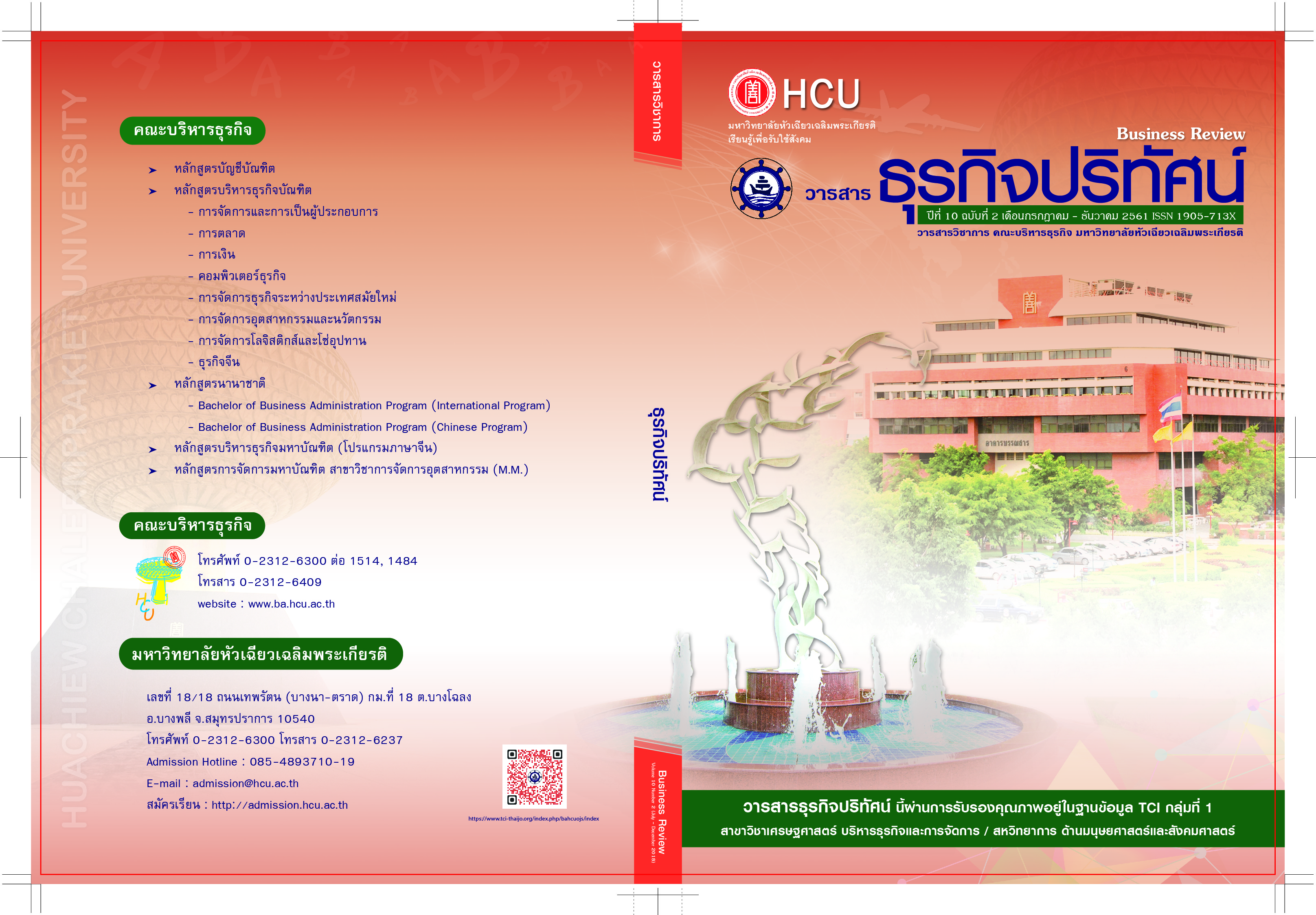The Antecedent and Consequent of Complexity Management Capability on Small and Medium Enterprises (SMEs) in Thailand
Keywords:
The Antecedent and Consequent, Complexity Management Capability, Small and Medium Enterprises (SMEs)Abstract
The purpose of this paper is to construct conceptual framework of the antecedent
and consequent of complexity management capability on small and medium enterprises
(SMEs) in Thailand.The study conducted by using a literature review and then document
analysis to construct a conceptual framework.The results indicated that the antecedents of
complexity management capability are 1) strategic leadership, 2) flexibility organizational
structure and 3) talent management.The consequent of complexity management capability are
1) competitive advantage and 2) business performance.
References
มหาวิทยาลัยหัวเฉียวเฉลิมพระเกียรติ. ปีที่ 8 ฉบับที่ 1 เดือนมกราคม-มิถุนายน 2559, 183-197.
สุวิทย์ เมษินทรีย์. (2556). โลกเปลี่ยน ไทยปรับ. กรุงเทพมหานคร. สำนักพิมพ์กรุงเทพธุรกิจ.
Abdullah, MA & Bin Bakar, M.I. (2000). Small and Medium Enterprise in Asian Pacific
Countries – Volume II: Linkages And Policy Support, Novan Science Publishers Inc,
Huntington, NY.
Al-Zboon Mohammad Saleem and Hasan Manal Subhi. (2011). Strategic School Planning in
Jordan, Education, Vol 132, N 4, pp 809-825.
Auh, S., & Menguc, B. (2005). Balancing exploration and exploitation: The moderating role of
competitive intensity. Journal of Business Research, 58 (12), 1652–1661.
Barney JB. (1991). Firm resources and sustained competitive advantage. J Management, 17(1),
99-120.
Barney, J.B., & Clark, D.N. (2007). Resource-based theory: Creating and sustaining competitive
advantage. Oxford: Oxford University Press.
Bell, J. (1995). The internationalization of small computer software firms: A further challenge to
“stage” theories. European Journal of Marketing, 29(8), 7–27.
Broche, G., & Marinescu, P. (2008). Deschideri spre lumea complexity, Ed. University din Bucureèti.
Calantone, R.J., Harmancioglu, N., Droge, C. (2010). Inconclusive innovation “returns”: a
metaanalysis of research on innovation in new product development. J. Prod. Innov.
Manag. 27(7), 1065–1081.
Cuhadar, T. and Ozmen, H. I. (2008). Mission Statement in Institutional Family Business: A
Content Analysis, First International Conference on Management and Economics
(ICME’08), Tirana, Albenia, 28-29 March, Pp. 120-132.
Culkin, N & Smith, D. (2000). ‘An Emotional Business: A Guide to Understanding the
Motivations of Small Business Decision Takers’, Qualitative Market Research : An
International Journal, 3 (3), 145-157.
Dekker, S., Cilliers, P., & Hofmeyr, J.-H. (2011). The complexity of failure: implications
ofcomplexity theory for safety investigations, Safety Science, 49, 939–945.
Dries, N. (2013). The psychology of talent management: A review and research agenda. Human
Resource Management Review, 23(4), 272–285.
Donaldson, L. (2001). The Contingency Theory of Organizations. Sage, London.
El Louadi M. (1998). The relationship among organization structure, information technology, and
information processing in small Canadian firms. Can J Admin Sci; 15(2): 180–99.
Fiedler, F. E. (1964). A Contingency Model of Leadership Effectiveness, Journal for Advances in
Experimental Social Psychology 1 (12), pp. 149-190.
Freel, M.S. (2005). Perceived environmental uncertainty and innovation in small firms. Small Bus.
Econ. 25, 49-64.
Galbraith, J. (1973). Designing Complex Organizations. Addison-Wesley: Reading, MA.
Galbraith, J. (1990). Designing complex organizations. Reading, MA’ Addison-Wesley.
Hambrick, D. C. (2007). Upper echelons theory: An update. Academy of Management Review, 32,
334-343.
Koetse,M.J., van der Vlist, A.J., de Groot, H.L.F. (2006). The impact of perceived expectations
and uncertainty on firm investment. Small Bus. Econ. 26 (4), 365–376.
Leenders, M., Voermans, C.A.M. (2007). Beating the odds in the innovation arena: the role
of market and technology signals classification and noise. Ind. Mark. Manag. 36 (4),
420-429.
Levy, B. (1993). Obstacles to developing indigenous small and medium enterprises: An empirical
assessment. The World Bank Economic Review, 7(1), 65-83.
Lin, F. J. (2016). The effect of network relationship on the performance of SMEs. Journal of
Business Research, 69, 1780–1784.
Migone, A.R. (1993). Non-linear constraint and incremental policymaking. The cases of the
unemployment insurance program and of the Canadian energy policies. Master of Arts
thesis, Department of Political Science, Simon Fraser University.
Miller D. (1991). Sale in the saddle: CEO tenure and the match between organization and
environment. Manage Sci; 37(1): 34–52.
Okreglicka, M., Gorzen-Mitka, I., & Ogrean, C. (2015). Management challenges in the context of
a complex view - SMEs perspective. Procedia Economics and Finance, 34, 445–452.
Palanisamy R. (2005). Strategic information systems planning model for building flexibility and
success. Ind Manage Data Syst; 105: 63–81 [January].
Reiman, T., Rollenhagen, C., Pietikäinen, E., Heikkilä, J. (2014). Principles of adaptive management
in complex safety– critical Organizations, Safety Science.
Rezaeian, A. (2010). System analysis and design, SAMT publications, 13rd edition (in Persian).
Richard, P., Devinney, M. (2009) : Measuring Organizational Performance : Towards
Methodological Best Practice. Journal of Management.
Sawyer, O.O. (1993). Environmental uncertainty and environmental scanning activities of Nigerian
manufacturing executives: a comparative analysis. Strateg. Manag. J. 14, 287–299.
Scott, W. R. (1992). Organizations: Rational, natural and open systems. Englewood Cliffs:
Prentice-Hall.
Shahram Mirzaei Daryani, A. A. (2016). Management and Organizational Complexity. Procedia -
Social and Behavioral Sciences, 230(3rd International Conference on New Challenges in
Management and Organization: Organization and Leadership, 2 May 2016, Dubai, UAE),
359 – 366.
Sipa, M. (2013). Wyzwania globalne i lokalne a proces umiedzynarodowienia małych i srednich
przedsiebiorstw in Wyzwania globalne i lokalne zarazdzania podmiotami
gospodarczymi”Sekcja Wydawnicza WZ Politechniki Czestochowskiej, Czestochowa, 48-
58.
Taminau, Y. (2006). Beyond known uncertainties: interventions at the fuel-engine interface. Res.
Policy 35 (2), 247–265.
Teece, D. (2014). The foundations of enterprise performance: Dynamic and ordinary capabilities
in an (economic) theory of firms. The Academy of Management Perspectives, 28(4),
328-352.
Teece, D.J., Pisano, G. & Shuen, A. (1997). Dynamic Capabilities and Strategic Management.
Strategic Management Journal, 18, 509-533.
Wang, Y. (2016). What are the biggest obstacles to growth of SMEs in developing countries?
An empirical evidence from an enterprise survey. Borsa Istanbul Review 16(3), 167-176.
Downloads
Published
How to Cite
Issue
Section
License
บทความที่ได้รับการตีพิมพ์เป็นลิขสิทธิ์ของวารสารธุรกิจปริทัศน์
ข้อความที่ปรากฏในบทความแต่ละเรื่องในวารสารวิชาการเล่มนี้เป็นความคิดเห็นส่วนตัวของผู้เขียนแต่ละท่านไม่เกี่ยวข้องกับมหาวิทยาลัยหัวเฉียวเฉลิมพระเกียรติ และคณาจารย์ท่านอื่น ๆ ในมหาวิทยาลัยฯ แต่อย่างใด ความรับผิดชอบองค์ประกอบทั้งหมดของบทความแต่ละเรื่องเป็นของผู้เขียนแต่ละท่าน หากมีความผิดพลาดใดๆ ผู้เขียนแต่ละท่านจะรับผิดชอบบทความของตนเองแต่ผู้เดียว




